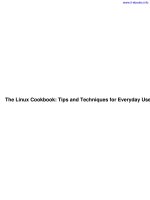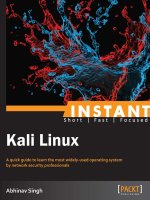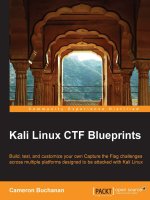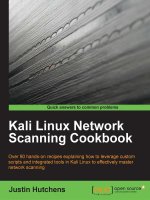Kali linux cookbook
Bạn đang xem bản rút gọn của tài liệu. Xem và tải ngay bản đầy đủ của tài liệu tại đây (10.65 MB, 261 trang )
Kali Linux Cookbook
Over 70 recipes to help you master Kali Linux for effective
penetration security testing
Willie L. Pritchett
David De Smet
BIRMINGHAM - MUMBAI
Kali Linux Cookbook
Copyright © 2013 Packt Publishing
All rights reserved. No part of this book may be reproduced, stored in a retrieval system,
or transmitted in any form or by any means, without the prior written permission of the
publisher, except in the case of brief quotations embedded in critical articles or reviews.
Every effort has been made in the preparation of this book to ensure the accuracy of the
information presented. However, the information contained in this book is sold without
warranty, either express or implied. Neither the authors, nor Packt Publishing, and its dealers
and distributors will be held liable for any damages caused or alleged to be caused directly or
indirectly by this book.
Packt Publishing has endeavored to provide trademark information about all of the companies
and products mentioned in this book by the appropriate use of capitals. However, Packt
Publishing cannot guarantee the accuracy of this information.
First published: October 2013
Production Reference: 1081013
Published by Packt Publishing Ltd.
Livery Place
35 Livery Street
Birmingham B3 2PB, UK.
ISBN 978-1-78328-959-2
www.packtpub.com
Cover Image by Prashant Timappa Shetty ()
Credits
Authors
Willie L. Pritchett
Project Coordinator
Wendell Palmer
David De Smet
Proofreaders
Reviewers
Daniel W. Dieterle
Maria Gould
Paul Hindle
Silvio Cesar Roxo Giavaroto
Adriano Gregório
Javier Pérez Quezada
Ahmad Muammar WK
Acquisition Editor
Usha Iyer
Lead Technical Editor
Balaji Naidu
Technical Editors
Proshonjit Mitra
Sonali S. Vernekar
Indexer
Priya Subramani
Production Coordinator
Melwyn D'sa
Cover Work
Melwyn D'sa
About the Authors
Willie L. Pritchett has a Master's in Business Administration. He is a seasoned developer
and security enthusiast who has over 20 years of experience in the IT field. He is currently the
Chief Executive at Mega Input Data Services, Inc., a full service database management firm
specializing in secure, data-driven, application development, and staffing services. He has
worked with state and local government agencies as well as helping many small businesses
reach their goals through technology. Willie has several industry certifications and currently
trains students on various topics including ethical hacking and penetration testing.
I would like to thank my wife Shavon for being by my side and supporting
me as I undertook this endeavor. To my children, Sierra and Josiah, for
helping me to understand the meaning of quality time. To my parents,
Willie and Sarah, I thank you for providing a work ethic and core set of
values that guide me through the roughest days. A special thanks to all of
my colleagues, associates, and business partners who gave me a chance
when I first started in the IT field; through you a vision of business ownership
wasn't destroyed, but allowed to flourish. Finally, I would like to thank all of
the reviewers and technical consultants who provided exceptional insight
and feedback throughout the course of writing this book.
David De Smet has worked in the software industry since 2007 and is the founder and
CEO of iSoftDev Co., where he is responsible for many varying tasks, including but not limited
to consultant, customer requirements specification analysis, software design, software
implementation, software testing, software maintenance, database development, and web
design. He is so passionate about what he does that he spends inordinate amounts of time
in the software development area. He also has a keen interest in the hacking and network
security field and provides network security assessments to several companies.
I would like to extend my thanks to Usha Iyer for giving me the opportunity
to get involved in this book, as well as my project coordinator Sai Gamare
and the whole team behind the book. I thank my family and especially
my girlfriend Paola Janahaní for the support, encouragement, and most
importantly the patience while I was working on the book in the middle of
the night.
About the Reviewers
Daniel W. Dieterle has over 20 years of IT experience and has provided various levels of
IT support to numerous companies from small businesses to large corporations. He enjoys
computer security topics, and is an internationally published security author. Daniel regularly
covers some of the latest computer security news and topics on his blog Cyberarms.
wordpress.com. Daniel can be reached via e-mail at or
@cyberarms on Twitter.
Silvio Cesar Roxo Giavaroto is a professor of Computer Network Security at
the University Anhanguera São Paulo in Brazil. He has an MBA in Information Security,
and is also a CEH (Certified Ethical Hacker). Silvio is also a maintainer of
www.backtrackbrasil.com.br.
Adriano Gregório is fond of operating systems, whether for computers, mobile phones,
laptops, and many more. He has been a Unix administrator since 1999, and is always
working on various projects involving long networking and databases, and is currently
focused on projects of physical security, and logical networks. He is being certified by
MCSA and MCT Microsoft.
Javier Pérez Quezada is an I + D Director at Dreamlab Technologies. He is the founder
and organizer of the 8.8 Computer Security Conference (www.8dot8.org). His specialties
include: web security, penetration testing, ethical hacking, vulnerability assessment, wireless
security, security audit source code, secure programming, security consulting, e-banking
security, data protection consultancy, consulting ISO / IEC 27001, ITIL, OSSTMM version 3.0,
BackTrack 4 and 5, and Kali Linux. He has certifications in: CSSA, CCSK, CEH, OPST, and
OPSA. Javier is also an instructor at ISECOM OSSTMM for Latin America (www.isecom.org).
Ahmad Muammar WK is an independent IT security consultant and penetration tester.
He has been involved in information security for more than 10 years. He is a founder of ECHO
( one of the oldest Indonesian computer security communities,
and also a founder of IDSECCONF () the biggest annual security
conference in Indonesia. Ahmad is well known in the Indonesian computer security community.
He also writes articles, security advisories, and publishes research on his blog,
.
www.PacktPub.com
Support files, eBooks, discount offers, and more
You might want to visit www.PacktPub.com for support files and downloads related to
your book.
Did you know that Packt offers eBook versions of every book published, with PDF and ePub
files available? You can upgrade to the eBook version at www.PacktPub.com and as a print
book customer, you are entitled to a discount on the eBook copy. Get in touch with us at
for more details.
At www.PacktPub.com, you can also read a collection of free technical articles, sign up
for a range of free newsletters and receive exclusive discounts and offers on Packt books
and eBooks.
Do you need instant solutions to your IT questions? PacktLib is Packt's online digital book
library. Here, you can access, read and search across Packt's entire library of books.
Why Subscribe?
ff
Fully searchable across every book published by Packt
ff
Copy and paste, print and bookmark content
ff
On demand and accessible via web browser
Free Access for Packt account holders
If you have an account with Packt at www.PacktPub.com, you can use this to access
PacktLib today and view nine entirely free books. Simply use your login credentials for
immediate access.
Table of Contents
Preface1
Chapter 1: Up and Running with Kali Linux
5
Introduction5
Installing to a hard disk drive
6
Installing to a USB drive with persistent memory
14
Installing in VirtualBox
17
Installing VMware Tools
24
Fixing the splash screen
25
Starting network services
26
Setting up the wireless network
27
Chapter 2: Customizing Kali Linux
31
Chapter 3: Advanced Testing Lab
47
Introduction31
Preparing kernel headers
31
Installing Broadcom drivers
33
Installing and configuring ATI video card drivers
35
Installing and configuring nVidia video card drivers
38
Applying updates and configuring extra security tools
40
Setting up ProxyChains
41
Directory encryption
43
Introduction47
Getting comfortable with VirtualBox
48
Downloading Windows Targets
56
Downloading Linux Targets
58
Attacking WordPress and other applications
59
Table of Contents
Chapter 4: Information Gathering
67
Chapter 5: Vulnerability Assessment
93
Chapter 6: Exploiting Vulnerabilities
141
Chapter 7: Escalating Privileges
171
Introduction67
Service enumeration
68
Determining network range
71
Identifying active machines
73
Finding open ports
74
Operating system fingerprinting
77
Service fingerprinting
79
Threat assessment with Maltego
80
Mapping the network
86
Introduction93
Installing, configuring, and starting Nessus
94
Nessus – finding local vulnerabilities
98
Nessus – finding network vulnerabilities
101
Nessus – finding Linux-specific vulnerabilities
105
Nessus – finding Windows-specific vulnerabilities
110
Installing, configuring, and starting OpenVAS
113
OpenVAS – finding local vulnerabilities
120
OpenVAS – finding network vulnerabilities
125
OpenVAS – finding Linux-specific vulnerabilities
130
OpenVAS – finding Windows-specific vulnerabilities
134
Introduction141
Installing and configuring Metasploitable
142
Mastering Armitage, the graphical management tool for Metasploit
146
Mastering the Metasploit Console (MSFCONSOLE)
149
Mastering the Metasploit CLI (MSFCLI)
151
Mastering Meterpreter
156
Metasploitable MySQL
158
Metasploitable PostgreSQL
160
Metasploitable Tomcat
163
Metasploitable PDF
165
Implementing browser_autopwn
167
Introduction171
Using impersonation tokens
171
Local privilege escalation attack
173
Mastering the Social Engineering Toolkit (SET)
175
Collecting the victim's data
180
ii
Table of Contents
Cleaning up the tracks
Creating a persistent backdoor
Man In The Middle (MITM) attack
181
183
185
Chapter 8: Password Attacks
191
Chapter 9: Wireless Attacks
219
Introduction191
Online password attacks
192
Cracking HTTP passwords
196
Gaining router access
201
Password profiling
204
Cracking a Windows password using John the Ripper
210
Using dictionary attacks
211
Using rainbow tables
213
Using nVidia Compute Unified Device Architecture (CUDA)
214
Using ATI Stream
216
Physical access attacks
217
Introduction219
Wireless network WEP cracking
220
Wireless network WPA/WPA2 cracking
222
Automating wireless network cracking
224
Accessing clients using a fake AP
227
URL traffic manipulation
230
Port redirection
231
Sniffing network traffic
232
Index239
iii
Table of Contents
iv
Preface
Kali Linux is a Linux-based penetration testing arsenal that aids security professionals in
performing assessments in a purely native environment dedicated to hacking. Kali Linux is
a distribution based on the Debian GNU/Linux distribution aimed at digital forensics and
penetration testing use. It is a successor to the popular BackTrack distribution.
Kali Linux Cookbook provides you with practical recipes featuring many popular tools that
cover the basics of a penetration test: information gathering, vulnerability identification,
exploitation, privilege escalation, and covering your tracks.
The book begins by covering the installation of Kali Linux and setting up a virtual environment
to perform your tests. We then explore recipes involving the basic principles of a penetration
test such as information gathering, vulnerability identification, and exploitation. You will learn
about privilege escalation, radio network analysis, voice over IP, password cracking, and Kali
Linux forensics.
Kali Linux Cookbook will serve as an excellent source of information for the security
professional and novice alike. The book offers detailed descriptions and example recipes
that allow you to quickly get up to speed on both Kali Linux and its usage in the penetration
testing field.
We hope you enjoy reading the book!
What this book covers
Chapter 1, Up and Running with Kali Linux, shows you how to set up Kali Linux in your testing
environment and configure Kali Linux to work within your network.
Chapter 2, Customizing Kali Linux, walks you through installing and configuring drivers
for some of the popular video and wireless cards.
Chapter 3, Advanced Testing Lab, covers tools that can be used to set up more advanced
simulations and test cases.
Preface
Chapter 4, Information Gathering, covers tools that can be used during the information
gathering phase including Maltego and Nmap.
Chapter 5, Vulnerability Assessment, walks you through the usage of the Nessus and
OpenVAS vulnerability scanners.
Chapter 6, Exploiting Vulnerabilities, covers the use of Metasploit through attacks on
commonly used services.
Chapter 7, Escalating Privileges, explains the usage of tools such as Ettercap, SET,
and Meterpreter.
Chapter 8, Password Attacks, walks you through the use of tools to crack password hashes
and user accounts.
Chapter 9, Wireless Attacks, walks you through how to use various tools to exploit the
wireless network.
What you need for this book
The recipes presented in this book assume that you have a computer system with enough
RAM, hard drive space, and processing power to run a virtualized testing environment. Many
of the tools explained will require the use of multiple virtual machines running simultaneously.
The virtualization tools presented in Chapter 1, Up and Running with Kali Linux, will run on
most operating systems.
Who this book is for
This book is for anyone who desires to come up to speed in using some of the more popular
tools inside of the Kali Linux distribution or for use as a reference for seasoned penetration
testers. The items discussed in this book are intended to be utilized for ethical purposes only.
Attacking or gathering information on a computer network without the owner's consent could
lead to prosecution and/or conviction of a crime.
We will not take responsibility for misuse of the information contained within this book.
For this reason, we strongly suggest, and provide instructions for, setting up your own
testing environment to execute the examples contained within this book.
Conventions
In this book, you will find a number of styles of text that distinguish between different kinds
of information. Here are some examples of these styles, and an explanation of their meaning.
Code words in text are shown as follows: "Another command we can use to examine a
Windows host is snmpwalk."
2
Preface
Any command-line input or output is written as follows:
nmap -sP 216.27.130.162
Starting Nmap 5.61TEST4 ( ) at 2012-04-27 23:30 CDT
Nmap scan report for test-target.net (216.27.130.162)
Host is up (0.00058s latency).
Nmap done: 1 IP address (1 host up) scanned in 0.06 seconds
New terms and important words are shown in bold. Words that you see on the screen,
in menus or dialog boxes for example, appear in the text like this: "clicking on the Next
button moves you to the next screen".
Warnings or important notes appear in a box like this.
Tips and tricks appear like this.
Reader feedback
Feedback from our readers is always welcome. Let us know what you think about this
book—what you liked or may have disliked. Reader feedback is important for us to develop
titles that you really get the most out of.
To send us general feedback, simply send an e-mail to ,
and mention the book title via the subject of your message.
If there is a topic that you have expertise in and you are interested in either writing
or contributing to a book, see our author guide on www.packtpub.com/authors.
Customer support
Now that you are the proud owner of a Packt book, we have a number of things to help you
to get the most from your purchase.
3
Preface
Errata
Although we have taken every care to ensure the accuracy of our content, mistakes do
happen. If you find a mistake in one of our books—maybe a mistake in the text or the
code—we would be grateful if you would report this to us. By doing so, you can save other
readers from frustration and help us improve subsequent versions of this book. If you find
any errata, please report them by visiting />selecting your book, clicking on the errata submission form link, and entering the details of
your errata. Once your errata are verified, your submission will be accepted and the errata will
be uploaded on our website, or added to any list of existing errata, under the Errata section
of that title. Any existing errata can be viewed by selecting your title from http://www.
packtpub.com/support.
Piracy
Piracy of copyright material on the Internet is an ongoing problem across all media. At Packt,
we take the protection of our copyright and licenses very seriously. If you come across any
illegal copies of our works, in any form, on the Internet, please provide us with the location
address or website name immediately so that we can pursue a remedy.
Please contact us at with a link to the suspected
pirated material.
We appreciate your help in protecting our authors, and our ability to bring you
valuable content.
Questions
You can contact us at if you are having a problem with any
aspect of the book, and we will do our best to address it.
4
1
Up and Running with
Kali Linux
In this chapter, we will cover:
ff
Installing to a hard disk drive
ff
Installing to a USB drive with persistent memory
ff
Installing in VirtualBox
ff
Installing VMware Tools
ff
Fixing the splash screen
ff
Starting network services
ff
Setting up the wireless network
Introduction
Kali Linux, or simply Kali, is the newest Linux distribution from Offensive Security. It is the
successor to the BackTrack Linux distribution. Unlike most Linux distributions, Kali Linux is
used for the purposes of penetration testing. Penetration testing is a way of evaluating the
security of a computer system or network by simulating an attack. Throughout this book,
we will further explore some of the many tools that Kali Linux has made available.
This chapter covers the installation and setup of Kali Linux in different scenarios,
from inserting the Kali Linux DVD to configuring the network.
For all the recipes in this and the following chapters, we will use Kali Linux using GNOME
64-bit as the Window Manager (WM) flavor and architecture ( />downloads/). The use of KDE as the WM is not covered in this book; however, you should
be able to follow the recipes without much trouble.
Up and Running with Kali Linux
Installing to a hard disk drive
The installation to a disk drive is one of the most basic operations. The achievement of this
task will let us run Kali Linux without the DVD.
Performing the steps covered in this recipe will erase your hard drive,
making Kali Linux the primary operating system on your computer.
Getting ready
Before explaining the procedure, the following requirements need to be met:
ff
A minimum of 8 GB of free disk space for the Kali Linux install (although, we
recommend at least 25 GB to hold additional programs and wordlists generated
with this book)
ff
A minimum of 512MB of RAM
ff
You can download Kali Linux at />
Let's begin with the installation.
How to do it...
1. Begin by inserting the Kali Linux Live DVD in the optical drive of your computer. You
will ultimately come to the Kali Linux Live DVD Boot menu. Choose Graphical install.
6
Chapter 1
2. Choose your language. In this case, we chose English.
3. Choose your location. In this case, we chose United States.
7
Up and Running with Kali Linux
4. Choose your keyboard configuration. In this case, we chose American English.
5. The next section to complete is the network services section. Enter a hostname.
In this case, we entered Kali.
8
Chapter 1
6. Next, we have to enter a domain name. In this case, we enter kali.secureworks.
com.
7. You will now be presented with the opportunity to choose the password for the root
user by entering a password twice.
9
Up and Running with Kali Linux
8. Choose your timezone. In this case, we chose Eastern.
9. We are now able to select our disk partition scheme. You will be presented with four
options. Choose Guided - use entire disk, as this allows for easy partitioning.
10
Chapter 1
10. At this step, you will need to acknowledge that your entire disc will be erased.
Click on Continue.
11. Next, you have the option of choosing one of three partitioning schemes: All files in
one partition, Separate/home partition, or Separate/home/user/var, and/tmp
partitions. Considering Kali is being used more so for penetration testing purposes,
a separation of partitions is not needed nor required (even though this is a great
idea for your main desktop Linux distribution). In this case, choose All files in one
partition and click on Continue.
11
Up and Running with Kali Linux
12. Once you get to the screen which lets you know that changes are about to be made
to your disks, choose Yes and click on Continue. Please note that this is the final
chance to back out of having all of your data on your disc overwritten.
13. Next, you will be asked if you want to connect to a network mirror. A network mirror
allows you to receive updates for Kali as they become available. In this case, we
choose Yes and click on Continue.
12









